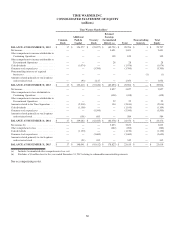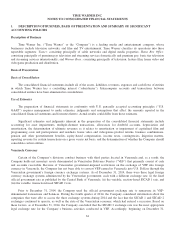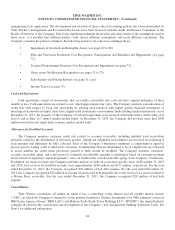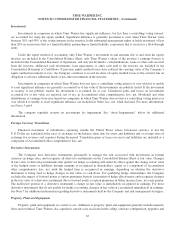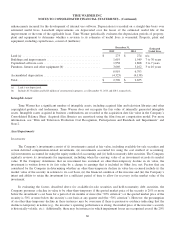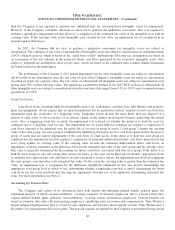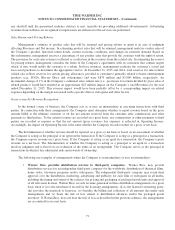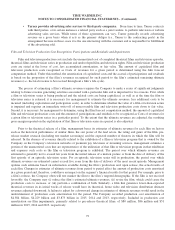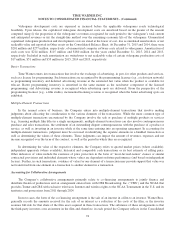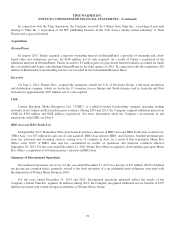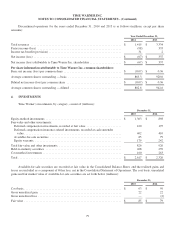Time Magazine 2015 Annual Report Download - page 83
Download and view the complete annual report
Please find page 83 of the 2015 Time Magazine annual report below. You can navigate through the pages in the report by either clicking on the pages listed below, or by using the keyword search tool below to find specific information within the annual report.TIME WARNER INC.
NOTES TO CONSOLIDATED FINANCIAL STATEMENTS - (Continued)
assumptions, including the expected long-term rate of return on plan assets, the interest factor implied by the discount rate
and the rate of compensation increases. For more information, see Note 13.
Equity-Based Compensation
The Company measures the cost of employee services received in exchange for an award of equity instruments based
on the grant-date fair value of the award. That cost is recognized in Costs of revenues or Selling, general and administrative
expenses depending on the job function of the grantee on a straight-line basis (net of estimated forfeitures) from the date of
grant over the period during which an employee is required to provide services in exchange for the award. The total grant-
date fair value of an equity award granted to an employee who has reached a specified age and years of service as of the
grant date is recognized as compensation expense immediately upon grant as there is no required service period.
The grant-date fair value of a restricted stock unit (“RSU”) is determined based on the closing sale price of the
Company’s common stock on the NYSE Composite Tape on the date of grant.
Performance stock units (“PSUs”) are subject to a performance condition such that the number of PSUs that ultimately
vest generally depends on the adjusted earnings per share (“Adjusted EPS”) achieved by the Company during a three-year
performance period compared to targets established at the beginning of the period. The PSUs are also subject to a market
condition and the number of PSUs that vest can be increased or decreased based on the Company’s cumulative total
shareholder return (“TSR”) relative to the TSR of the other companies in the S&P 500 Index for the performance period.
Because the terms of the PSUs provide discretion to make certain adjustments to the performance calculation, the service
inception date of these awards precedes the grant date. Accordingly, the Company recognizes compensation expense
beginning on the service inception date and remeasures the fair value of the PSU until a grant date occurs, which is typically
after the completion of the required service period. PSUs, as well as RSUs granted to certain senior executives, also are
subject to a performance condition based on an adjusted net income target for a one-year period that, if not achieved, will
result in the forfeiture of the awards.
The grant-date fair value of a stock option is estimated using the Black-Scholes option-pricing model.Because the
Black-Scholes option-pricing model requires the use of subjective assumptions, changes in these assumptions can materially
affect the fair value of the stock options. The Company determines the volatility assumption for these stock options using
implied volatilities data from its traded options. The expected term, which represents the period of time that stock options
granted are expected to be outstanding, is estimated based on the historical exercise behavior of Time Warner employees.
Groups of employees that have similar historical exercise behavior are considered separately for valuation purposes. The
risk-free rate assumed in valuing the options is based on the U.S. Treasury yield curve in effect at the time of grant for the
expected term of the option. The Company determines the expected dividend yield percentage by dividing the expected
annual dividend by the market price of Time Warner common stock at the date of grant. For more information, see Note 12.
Revenue
The Company generates revenue primarily from content production and distribution (i.e., Content Revenue), providing
programming to cable system operators, satellite distribution services, telephone companies and other distributors
(collectively, “affiliates”) that have contracted to receive and distribute this programming to their subscribers (i.e.,
Subscription Revenue) and the sale of advertising on the Company’s television networks and websites and the websites it
manages and/or operates for others (i.e., Advertising Revenue).
Content Revenue
Feature films typically are produced or acquired for initial exhibition in theaters, followed by distribution, generally
commencing within three years of such initial exhibition, through sales of feature films in physical format, electronic sell-
through, video-on-demand, subscription video-on-demand services, premium cable, basic cable and broadcast networks.
Revenues from film rentals by theaters are recognized as the films are exhibited. Revenues from sales of feature films in
69



